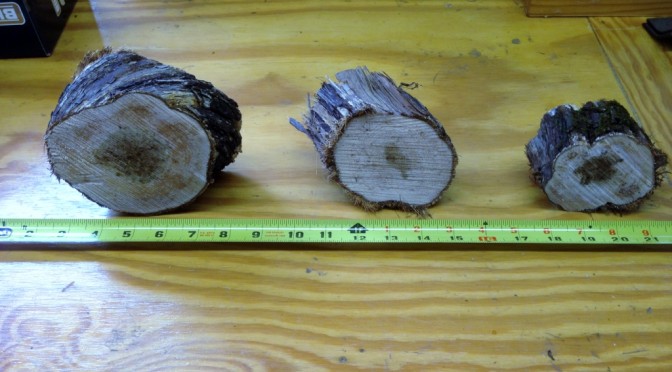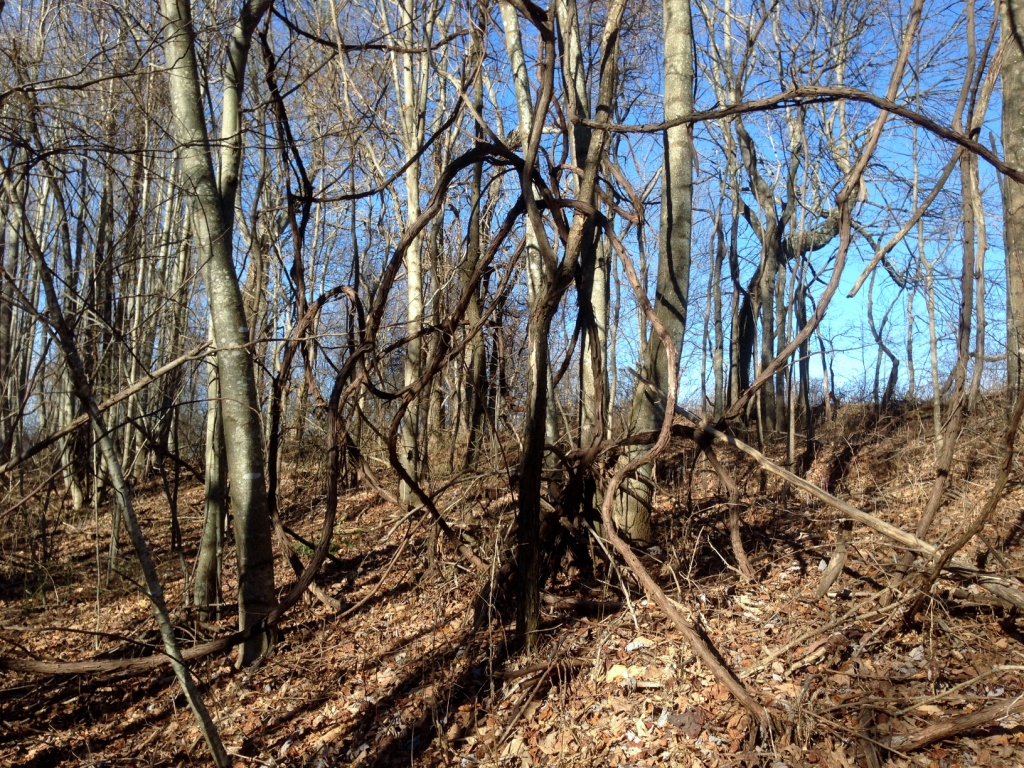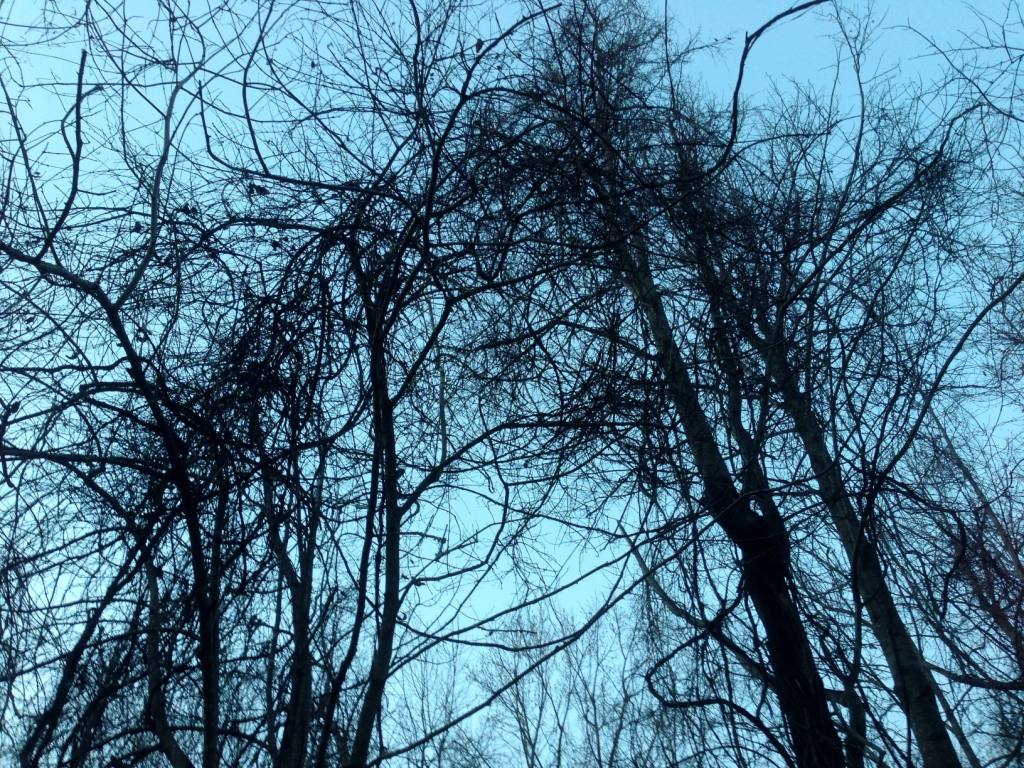“You can’t kill it. All you can really hope for is to control it,” is how a guest described the Kudzu he spotted in some trees behind our house while we were saying our goodbyes in the driveway. “It can grow up to two feet a day and the roots are so deep you can’t dig them out. Get yourself some goats.”
I had noticed a few small patches of Kudzu in the tops of those trees during the spring when I was returning bi-weekly to our recently purchased property to cut the grass, clean up and make repairs in preparation for our mid June move-in. But I was surprised how quickly the Kudzu had spread in just a few months. One or two feet of growth per day would help explain the rapid spread of this invasive species.
While I was aware of Kudzu, or more accurately its reputation as a tenacious and persistent pest, I was mostly ignorant of it simply because I had avoided dealing with it my entire life. Up to now no residence of mine had been infested, so for me ignorance was bliss. My limited experience with Kudzu consisted of glimpses of it while traveling various roads and highways as well as photos and articles about it in newspapers, magazines and various other publications.
Mrs. Cog and I had walked the property before we bought the place, but our inspection was mostly of the perimeter via the old logging road and during the height of winter. At that time our attention was captured by the fourteen hundred foot cliff along the back edge of the property with its spectacular view, as well as the ‘crick’ at a lower elevation and at the far end, a valuable second source of water that was very important to us.
What we saw was a moderately thick woods consisting of oak, poplar, some scattered maple, cherry and dogwood along with a smattering of pine and mountain laurel. As is the case with many things in life, very often we don’t see what we aren’t looking for.
The next day, after running some errands in the village center, I grabbed some gloves and the loppers and descended into the woods. What I found as I penetrated ever deeper was what I later discovered is called a ‘stand’ of Kudzu. The large leaves in the crowns of the trees visible from the driveway were the advancing edge of several acres of Kudzu nearly centered on our property with smaller patches scattered about.
Having done no research before heading in (this fool just rushed in) and not knowing what to expect, I was staggered to find nearly every tree near the center had two or more thick vines of one, two and sometimes three inches in diameter hanging down from the crown of the tree. While the thick vines had been visible from the logging road during the winter I had mistaken them for smaller trees or another type of hanging vine……when I even noticed them. Essentially my inexperienced eye didn’t see the vines from the trees.
Immediately I began cutting the Kudzu vines as high as I could reach because it was obvious I could not pull the vines out of the trees. At least I wanted the severed vines visible from a distance so I could tell at a glance what had been cut and what had not. While doing so I followed the vines as they snaked and coiled along the floor of the woods. What I found was a root and feeder system that was extensive and multifaceted and it became readily apparent to me that our friend was correct, that I wasn’t going to kill the Kudzu and my only hope was some sort of control.
Later reading confirmed my initial observation that this stand of Kudzu was not something that had started growing a few years back, but in fact was at least ten years old and probably as old as when it was last logged in 1995. It was clear to me that the previous owner had never cut any of these vines because some of the main feeder vines running along the forest floor were incredibly large, averaging three inches in diameter with some four or more.
At one point I followed a single feeder vine for well over one hundred feet as it moved along the ground from tree to tree. Actually to say that I was following one vine would be a misnomer because every five or ten feet it would dive back into the ground to create (or join) a new root system while continuing on. It was also branching off repeatedly in new directions both sideways and upward. This wasn’t a vine as much as a multi head hydra.
I marveled at how insidious the Kudzu was in creating multiple methods of surviving attack while it rapidly deployed its tentacles to overwhelm the trees above. The interconnections were too numerous to count and even more difficult to cut. It is a remarkable organic machine and it quickly garnered my respect as I cut the feeder roots every five or six feet in an effort to slow down what I fully expected would be a rapid recovery. It was exhausting work and after a few hours I grew tired from the upper body workout trying to use loppers designed to cut one and a half inch branches on the much larger Kudzu vines and feeders.
After the first day of cutting I had looked back from the driveway to see with some satisfaction that some of the Kudzu leaves the guest had pointed out where turning up and dying. I assumed the rest would start to turn soon enough, but the next morning I was disappointed to discover that this was not the case at all. Perplexed because I was certain I had cut all the vines running up that tree as well as all trees within 30 yards it suddenly dawned on me that any vine running up any tree could be feeding other vines in trees hundreds of yards away simply because of the nature of Kudzu propagation both above and below.
Later some additional research explained in detail the nature of the beast. Whether trying to control or eradicate, one must attack all of the Kudzu in the stand, particularly if it crosses property borders. If just one property owner is slack in his or her efforts or simply disinterested or inattentive the Kudzu retains and fortifies its beachhead for its annual push up and out. I was struck by the similarity to parasitic government agencies and corporate corruption which ultimately stifles and chokes out genuine productive endeavors.
As I probed the outer edges of the stand on the second day I began to find smaller patches of new growth. While previously I had been dealing with mature Kudzu, here were the advance shock troops of the stand. Once again I marveled at how well adapted this vine was to send out new shoots in all directions in order to exploit any and all weakness or openings it could find.
While attacking the mature stand was relatively easy, at least with regard to the two or three thick vines hanging from each tree, the leading edge was sending out dozens of thin green shoots with thorns making it extremely laborious and time consuming to find and cut each one. Here I could see how the mature feeder vines that ran along the floor and up the trees had morphed from a maze of young interconnections to much fewer but more robust permanent growth.
But it was also here at the edge of the attack that I truly began to recognize how damaging the Kudzu was both to the trees and the undergrowth. Most people who have walked in the woods know that under a stand of trees the woods floor is relatively passable with thick patches here and there of green bramble, ferns and smaller growth of trees and brush. This was exactly what I found beyond the leading edge of the Kudzu. But back near the center of the Kudzu the floor of the woods was almost completely devoid of any green growth what-so-ever, other than a stray fern or struggling small tree.
Very few life giving patches of sunlight penetrated the overhead cover anywhere and the ground was littered with deadwood and not much more. Dozens of smaller trees and a few large as well were dead or dying, but had remained standing mostly because of the support provided by the thick web of interconnected vines linked to the surrounding trees, an entirely different version of standing dead than I was familiar with.
Where a tree had fully or partially fallen, an event that would normally result in an area where sunlight would stream in and ignite the natural birth cycle of forest floor life, the canopy above was unbroken, the space vacated by a fallen tree quickly filled in by parasitic Kudzu from the surrounding trees. By the second day it was clear to me that the woods were not as healthy as I had thought. But it was just as obvious that somehow most of the trees had survived despite great stress and that they would rebound quickly now that I was giving them a fighting chance.
Mrs. Cog, who has lived further south than we are now and thus deeper into Kudzu territory, informed me that many do nothing about the Kudzu on their land, seeing it as a hopeless or futile effort. That can be a sad state of affairs for those next door or within the neighboring community who wish to put up a fight and make a stand.
With our back property line running along the cliff edge we have woods with no homes on the other three sides owned by three different families. Over the summer I have met with two of the owners and struck a Gentlemen’s agreement with each. In exchange for maintaining their property for them, be it cutting the grass in the open field across the street, cutting back the woods to maintain the road right of way or maintaining the logging roads running out to the next peak, I am allowed to ‘use’ their property and treat it as if it were my own, meaning use it with care and respect.
I expect to spend the winter months doing precisely that along with conducting the occasional Kudzu expedition, especially along the areas where their property buffers ours. Since these two owners don’t live on their property and rarely visit except once every few years I essentially have the run of the place.
Both Mrs. Cog and I feel very connected to this part of the mountain and I suspect the absent owners recognized this in us because both did not hesitate to give us permission to care for their land. This effectively has quadrupled the amount of land we can utilize for our own purposes. If nothing else there is lots of standing dead we can take down and burn in our water wood stove boiler.
We are well into January now and with the leaves down and the eye practiced in its search for the Kudzu vine I can see little patches of it nearly everywhere on our property as well as all the neighbors on three sides. Over the last 6 weeks or so, as we trimmed back the logging road along the back of our property parallel to the ridge/cliff edge, I took 30-45 minute forays deeper into the woods with the chainsaw and cut every Kudzu vine in sight. These woods will look very different come spring and quite frankly this pleases me to no end. And each time I cut back the Kudzu I feel the trees are pleased as well.
Cutting Kudzu, even if there is no hope of eradication or even effective control, does not define pointless or futile. Not by a long shot. One person can make a difference, if only within his or her sphere of influence. What more can we really ask of ourselves or anyone else?
Ultimately we determine where our energy will be directed and if doing so will be productive or not. If we can derive pleasure and happiness from an act or activity, rather than just the results, we alone determine the quality and fullness of our lives.
02-27-2014
Cognitive Dissonance
For more images and observations on Cutting Kudzu see my page on the subject. On the Mountain > Clearing and Caring for the Land > Cutting Kudzu




